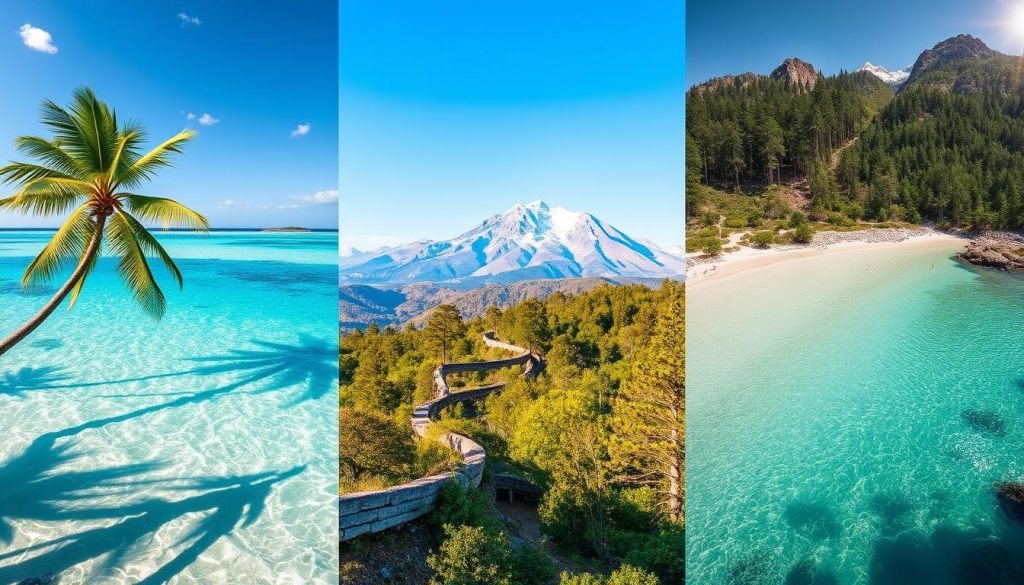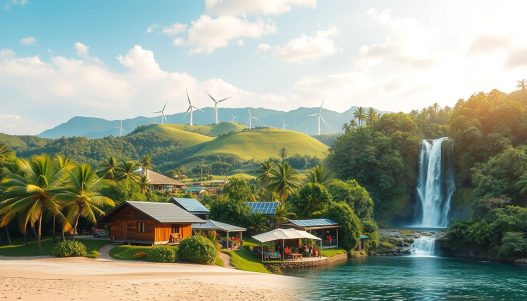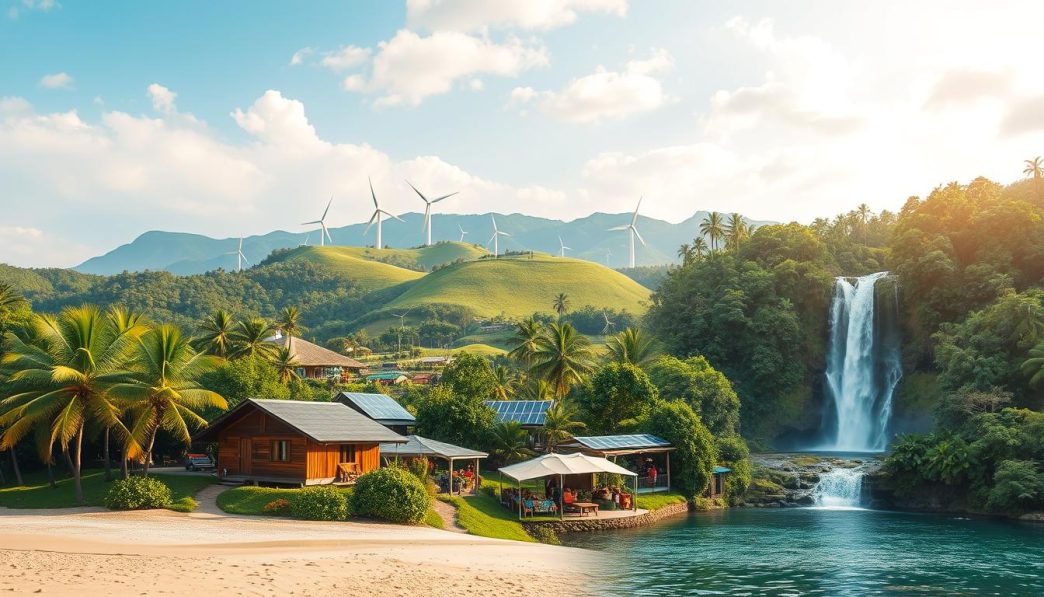The world is waking up to the harm tourism can cause. Responsible tourism is now more important than ever. A report by Nature Climate Change shows tourism is behind 8% of greenhouse gas emissions. This shows we need more eco-friendly destinations.
Travelers are now thinking more about their impact on the planet. Green travel is becoming more common. This article will look at the best eco-friendly vacation options. We’ll dive into sustainable practices and how to travel responsibly.
By picking sustainable travel options, we can lessen our environmental harm. And we get to enjoy special and meaningful experiences.
Key Takeaways
- Eco-friendly destinations are becoming increasingly popular among travelers.
- Responsible tourism practices can significantly reduce greenhouse gas emissions.
- Green travel initiatives are on the rise, promoting sustainable tourism.
- Sustainable travel options offer unique and enriching experiences.
- Travelers can make a positive impact by choosing eco-friendly destinations.
Why Sustainable Travel Matters
As we learn more about the environment, sustainable travel is becoming key. Our travel choices affect the planet a lot. It’s crucial to think about how our actions impact the earth.
Environmental Impact of Traditional Tourism
Traditional tourism causes big environmental problems. These include greenhouse gas emissions, pollution, and destroying habitats. The tourism industry is a big part of these issues. Air travel, staying in hotels, and activities all play a role.
Benefits of Choosing Eco-Friendly Destinations
Choosing eco-friendly places has many benefits. These include:
- Supporting conservation efforts
- Promoting sustainable practices
- Helping local economies
- Keeping natural habitats safe
The Growing Trend of Responsible Tourism
More people want to travel responsibly now. They’re looking for places that care about the environment. This trend is changing the tourism industry for the better.
By making smart choices, we can help make the planet more sustainable for the future.
What Makes a Destination Truly Sustainable
A sustainable destination balances nature with community benefits. It attracts eco-aware travelers and helps the local environment and people.
Environmental Conservation Efforts
Protecting nature is key in sustainable places. This means saving habitats, keeping species diverse, and encouraging green habits. Costa Rica is famous for its efforts, with lots of land for parks and wildlife.
Community Involvement and Benefits
Getting locals involved in tourism is crucial. Places that do this well see better results. They support local shops, celebrate culture, and make sure tourism helps everyone.
Sustainable Infrastructure and Practices
Good infrastructure helps tourism be less harmful. This includes:
- Renewable energy usage
- Efficient waste management systems
- Sustainable building practices
Renewable Energy Usage
Using solar or wind power cuts down on fossil fuel use. Norway leads in using green energy for its tourism.
Waste Management Systems
Good waste handling keeps places beautiful and healthy. Recycling, composting, and avoiding single-use plastics are important steps.
By focusing on these areas, places can offer a great visit while caring for the planet and supporting locals.
Costa Rica: The Pioneer of Eco-Tourism
Costa Rica is a world leader in eco-tourism. It shows its dedication to nature and conservation. A big part of its land is protected, making it a model for caring for the environment.
Biodiversity and Conservation Success
Costa Rica’s rich nature comes from its geography. It has rainforests, mountains, and coastlines by the Pacific and Caribbean Sea. Thanks to its conservation, many unique species are protected here.
Sustainable Accommodations in Costa Rica
In Costa Rica, you can find many eco-friendly places to stay. Eco-lodges in the rainforest let you live among nature. They also help protect the environment.
Eco-Lodges in the Rainforest
Eco-lodges are built to fit into their surroundings. They offer a peaceful place for visitors. Many also have tours and activities that help local communities.
Coastal Sustainable Resorts
Coastal resorts in Costa Rica are also green. They use renewable energy and reduce waste. These resorts provide luxury while helping the environment.
Activities That Support Local Communities
Visitors can help local economies in many ways. They can join tours led by locals, help with conservation, and support community tourism.
| Activity | Location | Impact |
|---|---|---|
| Guided Rainforest Tours | Corcovado National Park | Supports conservation efforts and local guides |
| Surfing Lessons | Tamarindo | Promotes eco-friendly tourism and local economy |
| Wildlife Conservation Projects | Monteverde | Contributes to the protection of unique species |
Scandinavian Eco-Havens: Norway, Sweden, and Finland
The Scandinavian region is a top choice for eco-conscious travelers. Norway, Sweden, and Finland are leading the way in sustainable tourism. They offer eco-friendly experiences that let visitors enjoy nature while keeping their environmental impact low.
Zero-Emission Transportation Options
Scandinavian eco-havens are known for their zero-emission transportation. Electric vehicles are becoming more common. Many cities have efficient public transport systems, making it easy to travel without polluting.
Sustainable Urban Planning
Scandinavian cities are examples of sustainable urban planning. They have green spaces, pedestrian-friendly zones, and innovative waste management. For instance, Copenhagen’s carbon-neutral heating system is a model for other cities.
Eco-Friendly Outdoor Adventures
Scandinavia is perfect for outdoor lovers. There are plenty of eco-friendly adventures like hiking, camping, dog sledding, and skiing. These activities let visitors enjoy nature responsibly.
Responsible Northern Lights Tourism
The Northern Lights attract many visitors in Scandinavia. Responsible tourism ensures this experience is both fun and sustainable. Many tour operators offer eco-friendly Northern Lights tours that reduce environmental impact.
Sustainable Hiking and Camping
Sustainable hiking and camping are big in Scandinavia. Visitors can explore stunning landscapes while following eco-friendly guidelines. This includes staying on designated trails and using eco-friendly camping gear.
New Zealand’s Commitment to Sustainable Tourism
New Zealand is a leader in sustainable tourism. It combines cultural heritage with environmental care. The country works hard to keep its natural beauty safe through many conservation efforts.
Maori-Led Conservation Initiatives
The Maori people are key in New Zealand’s conservation. Maori-led conservation initiatives aim to protect the country’s culture and wildlife. These efforts also give visitors a special cultural experience.
Carbon-Neutral Accommodations
New Zealand has many carbon-neutral accommodations. These range from fancy lodges to green campsites. They use eco-friendly materials and practices to reduce their impact on the environment.
Responsible Wildlife Encounters
New Zealand offers responsible wildlife encounters. Visitors can see its unique animals up close. These experiences help conservation and give unforgettable moments.
Marine Conservation Experiences
Visitors can join marine conservation experiences. Activities like dolphin watching and sea turtle projects are available. They teach about marine life and why it needs protection.
Bird Sanctuary Visits
Bird sanctuary visits show New Zealand’s dedication to conservation. These places are safe for native birds. Visitors can see these birds in their natural home.
Sustainable Travel Destinations: Eco-Friendly Vacation Options in the United States
The United States has many eco-friendly vacation spots. These places are perfect for those who love the environment. From the Pacific coast to the Hawaiian islands, there’s a lot to see.
Portland, Oregon: America’s Greenest City
Portland is known for its green efforts. It’s a top choice for eco-friendly travelers. The city is famous for its sustainable food scene and eco-friendly transportation.
Sustainable Food Scene
Portland’s food focuses on local and organic ingredients. Restaurants here offer tasty, green menus. It’s a great place for food lovers who care about the planet.
Eco-Friendly Transportation
The city has lots of bike lanes and public transport. This makes it easy to explore without a car. It’s good for the environment and makes travel better.
Vermont’s Farm-to-Table Tourism
Vermont is perfect for farm-to-table experiences. The state has many farms and agricultural projects. Visitors can connect with local food systems here.
Hawaii’s Sustainable Island Initiatives
Hawaii leads in sustainable island tourism. It focuses on protecting nature. Key efforts include coral reef protection programs and renewable energy resorts.
Coral Reef Protection Programs
Hawaii’s coral reefs are vital and beautiful. Efforts protect them from tourism and climate change. It’s a big part of the local ecosystem.
Renewable Energy Resorts
Many Hawaiian resorts use renewable energy. This reduces their carbon footprint. It’s a big step towards a greener tourism industry.

These places show the U.S.’s dedication to green travel. Visiting Portland, Vermont, and Hawaii supports eco-friendly practices. It’s a win-win for both travelers and the planet.
Eco-Friendly Island Getaways
Travelers looking for a peaceful retreat will find eco-friendly island getaways perfect. Places like Palau, the Azores, and Dominica lead in protecting the environment and promoting sustainable tourism.
Palau’s Environmental Protection Measures
Palau is a leader in conservation with its Protected Areas Network. This network works to keep the island’s diverse wildlife safe. Visitors must sign the Palau Pledge, promising to care for the environment.
The Azores: Portugal’s Sustainable Paradise
The Azores is a top spot for eco-tourists. It uses geothermal energy to power homes and businesses. The islands’ green landscapes and dedication to sustainability draw in eco-conscious travelers.
Dominica: The Nature Island
Dominica is called “The Nature Island” for good reason. It’s full of natural wonders like hot springs and waterfalls. The island is investing in geothermal energy and rebuilding after hurricanes with sustainable development.
Geothermal Energy Initiatives
Dominica’s geothermal projects aim to cut down on fossil fuel use. They’re working towards a cleaner, greener energy future.
Hurricane Recovery Through Sustainable Development
After tough hurricanes, Dominica is rebuilding with green practices. This ensures its natural beauty will be enjoyed by future visitors.
Sustainable Safari Experiences in Africa
Sustainable safari experiences are becoming more popular in Africa. This is thanks to community-led conservation efforts. These efforts make travel better for visitors and help protect Africa’s wildlife and support local economies.
Community-Owned Conservancies in Kenya
In Kenya, community-owned conservancies are leading the way. They are run by local people, making sure everyone gets a fair share of tourism benefits. This approach has helped protect wildlife and their homes.
Namibia’s Award-Winning Conservation Model
Namibia’s conservation model is also worth noting. It focuses on community-based management of natural resources. This model protects Namibia’s wildlife and helps local people make a living.
Rwanda’s Eco-Tourism Renaissance
Rwanda is making big strides in eco-tourism. Gorilla Conservation Tourism lets visitors see mountain gorillas in their natural home. This helps people appreciate these amazing animals and supports their protection.
Gorilla Conservation Tourism
This tourism is key for mountain gorillas’ survival. Visitors help protect these endangered animals and their homes by supporting conservation.
Local Economic Development Through Tourism
Eco-tourism in Rwanda also boosts local economic development. Local communities gain from tourism, which encourages them to protect their environment.
Eco-Friendly Urban Escapes
Travelers are now looking for cities that care about the environment. Places like Copenhagen, Singapore, and Ljubljana are leading the way. They offer a mix of culture and green living.
Copenhagen: Carbon-Neutral Capital
Copenhagen aims to be the first carbon-neutral capital by 2025. It’s known for its eco-friendly transportation and green roofs. You can see the CopenHill waste-to-energy plant, which has a ski slope and hiking trail.
Singapore: The Garden City
Singapore is a green oasis in the city. It’s famous for its innovative urban planning and sustainable architecture. Don’t miss the Gardens by the Bay, with its amazing floral displays and Supertree structures.
Ljubljana: Europe’s Green Capital
Ljubljana is Europe’s Green Capital. It’s known for its car-free city center and urban recycling innovations. These efforts make it a great place to visit.
Car-Free City Center
Ljubljana’s city center is perfect for walking and cycling. It has beautiful riverside paths and lively public areas. This has cut down on carbon emissions and improved life for everyone.
Urban Recycling Innovations
The city has cool recycling programs. It has a waste separation system and recycling centers. These efforts have greatly reduced its environmental impact, setting a good example for others.

Emerging Sustainable Destinations
The world is moving towards eco-friendly travel. New places are getting attention for their green efforts. They’re cutting down on waste and involving local communities in their work.
Guyana’s Low-Carbon Development Strategy
Guyana is leading in sustainable growth. It’s keeping its rainforests safe while boosting eco-tourism. This shows other countries how to lower their carbon output.
Slovenia’s Green Scheme Certification
Slovenia has a green scheme for tourism. It pushes for practices that are good for the planet. This makes it a hit with travelers who care about the environment.
Monteverde, Costa Rica: Community-Based Tourism
Monteverde in Costa Rica is all about community tourism. The locals run the show, keeping the area’s beauty and economy strong. It’s a win-win for nature and people.
“Sustainable tourism is not just a trend; it’s a necessity for our planet’s future.” Places like Guyana, Slovenia, and Monteverde are showing the way. By visiting these spots, we help make travel better for our planet.
How to Plan Your Eco-Friendly Vacation
Planning an eco-friendly vacation means thinking carefully about your impact. Consider how your choices affect the environment and local communities.
Choosing Certified Sustainable Accommodations
Choosing where to stay is a big decision. Look for certified sustainable accommodations. These places use green energy, save water, and recycle.
Check for LEED or EarthCheck certifications. They show the place meets high sustainability standards. Staying in eco-friendly places helps the planet.
Reducing Your Carbon Footprint While Traveling
Traveling creates carbon emissions, but you can lessen them. Choose direct flights and trains or buses over cars or private transfers.
Carbon Offset Programs
For emissions you can’t avoid, join carbon offset programs. They fund projects that cut greenhouse gases, like planting trees or using green energy. This helps the planet.
Sustainable Packing Tips
Packing smart is good for the environment. Use reusable bags, bottles, and containers. Pick clothes made from sustainable materials and pack items that serve more than one purpose.
Supporting Local Economies Responsibly
Make sure your money helps the local community. Support local shops, artisans, and guides. This enriches your trip and helps local economies grow.
By choosing wisely, you can have a great eco-friendly vacation. It will also help the places you visit.
Conclusion
The world faces big environmental challenges. Sustainable travel is key to solving these problems. By picking eco-friendly destinations and practicing responsible tourism, we can help the planet.
This article has shown many green travel options. Places like Costa Rica and Africa offer eco-tourism and sustainable safaris. These choices support conservation and local communities.
Travelers can make a big difference by choosing sustainable travel and responsible tourism. As we move forward, sustainable travel will play a bigger role. It will help create a greener future for all.






